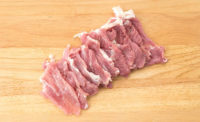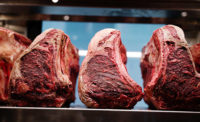Connective tissue sheaths serve as the scaffolds in skeletal muscle, and they allow for the growth and development of muscle tissue. However, these connective tissues also cause the “background toughness” in meat. Therefore, meat tends to be less tender when there is a high amount of connective tissue present. Collagen is the main component of connective tissue, and it is stabilized by both immature and mature crosslinks. The heat-labile immature crosslinks mainly exist in younger animals, and they transform into heat-stable mature crosslinks as animal age. Pyridinoline (PYD) and deoxypyridinoline (DPD) are major mature collagen crosslinks. PYD is mainly found in muscles, while DPD is found in bones. PYD and DPD densities vary among muscles depending on their location and functionality.
Some collagen forms are immediately solubilized upon heat treatment, and there are collagen structures that cannot be solubilized even with extensive heat treatment. These heat insoluble collagen tissues that remain in meat after cooking are the main contributor to the “background toughness” of the meat. However, the heat insoluble collagen is not well characterized, and the factors affecting collagen solubility are not well understood. Asian consumers were selected to participate in the sensory panel of the current study due to their culture and familiarity to beef shank cuts. Although beef shank cuts are not well sought after in the U.S., stewed beef shank is widely consumed in many Asian cultures, particularly in China in the form of “sauced beef.” Therefore, our goal was to investigate mature collagen crosslink densities and their relationship to cooked beef tenderness and connective tissue texture by using a stewed beef shank model.
Beef shank cuts from both sides of the carcass, three from the foreshank [biceps brachii (BB); deep digital flexor from foreshank (DDF-F); extensor carpi radialis (ECR)] and three from the hindshank [flexor digitorum superficialis (FDS), deep digital flexor from hindshank (DDF-H), a combination of long digital extensor, medial digital extensor and peroneus tertius (LMP)] were utilized. Shanks from the right side of the carcasses were designated for raw treatment, and shanks from the left side of the carcasses were designated for the cooked treatment; they were stewed in water for 90 minutes at 199°F. Asian consumers that were primarily Chinese participated in sensory panels, and consumers were asked to evaluate each sample for connective tissue texture on a Just About Right (JAR) line scale. Anchors were set at 0, 50, and 100, with 0 being too soft, 50 as the ideal score that anchored as JAR, and 100 being too hard. Warner-Bratzler shear force (WBSF) values was also obtained for cooked beef shanks. Mature collagen crosslinks densities (PYD and DPD) and collagen content were measured for both raw and cooked shanks by utilizing ultra-performance lipid chromatography (UPLC). The collagen contents were adjusted to dry matter basis (DM) based on moisture content of the raw and cooked shanks to account for moisture loss during the cooking process. Finally, relative percentages of soluble and insoluble collagen content were calculated.
Based on the results, DDF-F had the toughest connective tissue texture, greatest shear force value, most cooked collagen content, greatest insoluble collagen percentage as well as greatest raw and cooked PYD densities among all the beef shank cuts. It was interesting to note that DDF-F, FDS, and LMP all started with similar raw collagen content, but DDF-F ended with greater cooked collagen content than the others. Moreover, cooking only decreased PYD density for DDF-F, and PYD density for the rest of the beef shank cuts was not affected by cooking. For DPD density, ECR had the greatest DPD density among all cuts for both raw and cooked samples. Again, there was a cooking effect in which cooking decreased DPD density for DDF-F, ECR, and FDS, but not for the other cuts. As expected, beef shanks with toughest connective tissue texture and higher WBSF value also had higher cooked collagen content, insoluble collagen percentage as well as raw PYD density.
These results indicated that cooked (insoluble) collagen is what contributed to the background toughness, and PYD is a heat-stable collagen crosslink that may require extensive heat treatment to degrade to allow for the solubilization of collagen. As a result, raw PYD density may be a good indicator and we may consider using it to predict cooked collagen content, cooked beef connective tissue texture — and, ultimately, tenderness in beef cuts with high concentration of connective tissue prepared with moist heat cookery. NP




Report Abusive Comment